Astronomy/Airborne
< Astronomy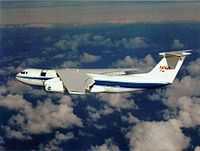
Astronomy that benefits from using either an airborne observatory or such a telescope of detector system is airborne astronomy.
Airborne observatory
“An airborne observatory is an airplane or balloon with an astronomical telescope. By carrying the telescope high, the telescope can avoid cloud cover, pollution, and carry out observations in the infrared spectrum, above water vapor in the atmosphere which absorbs infrared radiation.”[1]
Observation posts

“An observation post, temporary or fixed, is any preselected position from which observations are to be made - this may include very temporary installations ... or even an airborne aircraft.[2][3]"[4][5].
Gamma rays
"Airborne gamma-ray spectrometry is now the accepted leading technique for uranium prospecting with worldwide applications for geological mapping, mineral exploration & environmental monitoring."[6]
Balloon flights
"On June 19, 1988, from Birigüi (50° 20' W 21° 20' S) at 10:15 UTC a balloon launch occurred which carried two NaI(Tl) detectors (600 cm2 total area) to an air pressure altitude of 5.5 mb for a total observation time of 6 hr.[7] The supernova SN1987A in the Large Magellanic Cloud (LMC) was discovered on February 23, 1987, and its progenitor is a blue supergiant (Sk -69 202) with luminosity of 2-5 x 1038 erg/s.[7] The 847 keV and 1238 keV gamma-ray lines from 56Co decay have been detected.[7]"[8]
"Gamma rays at energies of 0.3 to 8 megaelectron volts (MeV) were detected on 15 April 1988 from four nuclear-powered satellites including Cosmos 1900 and Cosmos 1932 as they flew over a double Compton gamma-ray telescope."[9]
Infrareds
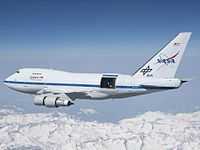
“The Gerard P. Kuiper Airborne Observatory (KAO) was a national facility operated by NASA to support research in infrared astronomy. The observation platform was a highly modified C-141A jet transport aircraft with a range of 6,000 nautical miles (11,000 km), capable of conducting research operations up to 48,000 feet (14 km). The KAO was based at the Ames Research Center, NAS Moffett Field, in Sunnyvale, California. It began operation in 1974 as a replacement for an earlier aircraft, the Galileo Observatory, a converted Convair CV-990 (N711NA)”[10].
The "Stratospheric Observatory for Infrared Astronomy [(SOFIA) is] mounted onboard a Boeing 747SP. [...] SOFIA’s 2.7 m mirror and optimized telescope system combines the highest available spatial resolution with excellent sensitivity. SOFIA will operate in both celestial hemispheres for the next two decades."[11]
It has an operating altitude of 12-14 km, 39,000-45,000 ft and a spatial resolution of 1-3" for 0.3 < λ < 15 µm, and λ/10" for λ > 15 µm.[11]
Radars
"[N]umerous airborne and spacecraft radars have mapped the entire planet, for various purposes. One example is the Shuttle Radar Topography Mission, which mapped the entire Earth at 30 m resolution."[12]
Craters
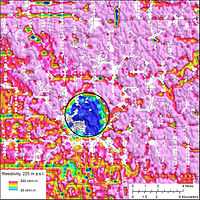
- Buried craters can be identified through drill coring, aerial electromagnetic resistivity imaging, and airborne gravity gradiometry.[13]
At right is a "[r]ecent airborne geophysical surveys near Decorah, Iowa [which is] providing an unprecedented look at a 470- million-year-old meteorite crater concealed beneath bedrock and sediments."[14]
"Capturing images of an ancient meteorite impact was a huge bonus," said Dr. Paul Bedrosian, a USGS geophysicist in Denver who is leading the effort to model the recently acquired geophysical data.[14] "These findings highlight the range of applications that these geophysical methods can address."[14]
"In 2008-09, geologists from the Iowa Department of Natural Resources' (Iowa DNR) Iowa Geological and Water Survey hypothesized what has become known as the Decorah Impact Structure. The scientists examined water well drill-cuttings and recognized a unique shale unit preserved only beneath and near the city of Decorah. The extent of the shale, which was deposited after the impact by an ancient seaway, defines a "nice circular basin" of 5.5 km width, according to Robert McKay, a geologist at the Iowa Geological Survey."[14]
"Bevan French, a scientist the Smithsonian's National Museum of Natural History, subsequently identified shocked quartz - considered strong evidence of an extra-terrestrial impact - in samples of sub-shale breccia from within the crater."[14]
"The recent geophysical surveys include an airborne electromagnetic system, which is sensitive to how well rocks conduct electricity, and airborne gravity gradiometry, which measures subtle changes in rock density. The surveys both confirm the earlier work and provide a new view of the Decorah Impact Structure. Models of the electromagnetic data show a crater filled with electrically conductive shale and the underlying breccia, which is rock composed of broken fragments of rock cemented together by a fine-grained matrix."[14]
"The shale is an ideal target and provides the electrical contrast that allows us to clearly image the geometry and internal structure of the crater," Bedrosian said.[14]
Earth

In the image at left is an aerial view of the Barringer Meteor Crater about 69 km east of Flagstaff, Arizona USA. Although similar to the aerial view of the Soudan crater, the Barringer Meteor Crater appears angular at the farthest ends rather than round.
Infrared telescopes
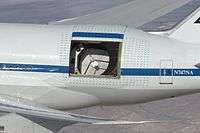
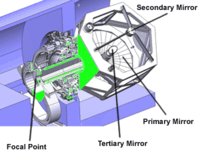
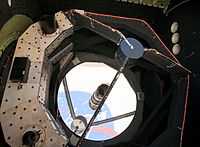
"SOFIA’s primary mirror, located near the bottom of the telescope, is 2.7 meters (almost 9 feet) across. The front surface, which is highly polished and then coated with Aluminum to ensure maximum reflectivity, is deeply concave (dished inward). Incoming light rays bounce off the curved surface and are all deflected inward at the same time they are reflected back up toward the front of the telescope."[15]
"Before the light reaches the telescope’s front end, however, it is intercepted by a small secondary mirror (about .4 meters across), which sends the light back down toward the center of the main mirror. About a meter above the center of the main mirror, a third mirror sends the light out through the side of the telescope, down a long tube which projects through the main aircraft bulkhead into the interior of the SOFIA aircraft. There, at the telescope’s focal point, the light will be recorded and analyzed by one of several different instruments."[15]
"Astronomers tend to compare telescopes based on the diameter of their primary mirrors. SOFIA’s telescope is usually referred to as a 2.5-meter meter telescope, rather than 2.7 meters, because the optical design requires that only about 90% of the mirror’s reflecting surface (called the "effective aperture") can be used at any one time. Although SOFIA’s telescope is by far the largest ever to be placed in an aircraft, compared to normal ground-based research observatories it is only medium-sized (the world’s largest single-mirror telescope, the Subaru, is 8.2 meters across)."[15]
Research
Hypothesis:
- Extremely high altitude powered flight may allow observation at a lower cost than a satellite.
Control groups

The findings demonstrate a statistically systematic change from the status quo or the control group.
“In the design of experiments, treatments [or special properties or characteristics] are applied to [or observed in] experimental units in the treatment group(s).[16] In comparative experiments, members of the complementary group, the control group, receive either no treatment or a standard treatment.[17]"[18]
Proof of concept
Def. a “short and/or incomplete realization of a certain method or idea to demonstrate its feasibility"[19] is called a proof of concept.
Def. evidence that demonstrates that a concept is possible is called proof of concept.
The proof-of-concept structure consists of
- background,
- procedures,
- findings, and
- interpretation.[20]
Proof of technology
"[T]he objective of a proof of technology is to determine the solution to some technical problem, such as how two systems might be integrated or that a certain throughput can be achieved with a given configuration."[21]
Def.
- "[a]n original object or form which is a basis for other objects, forms, or for its models and generalizations",[22]
- "[a]n early sample or model built to test a concept or process",[22] or
- "[a]n instance of a category or a concept that combines its most representative attributes"[22] is called a prototype.
Def. "[t]o test something using the conditions that it was designed to operate under, especially out in the real world instead of in a laboratory or workshop"[23] is called "field-test", or a field test.
A "proof-of-technology prototype ... typically implements one critical scenario to exercise or stress the highest-priority requirements."[24]
"[A] proof-of-technology test demonstrates the system can be used"[25].
"The strongest proof of technology performance is based on consistency among multiple lines of evidence, all pointing to similar levels of risk reduction."[26]
See also
References
- ↑ "Airborne observatory, In: Wikipedia". San Francisco, California: Wikimedia Foundation, Inc. July 4, 2012. Retrieved 2012-12-09.
- ↑ DoD News Briefing, February 15, 1996 1:30 pm EST (from a [United States Department of Defense] DoD news briefing. Accessed 2008-06-21.)
- ↑ Francoise Micheau (1996). The Scientific Institutions in the Medieval Near East, In:. pp. 992–3.
- ↑ "Observation post, In: Wikipedia". San Francisco, California: Wikimedia Foundation, Inc. August 30, 2012. Retrieved 2012-10-09.
- ↑ "Observatory, In: Wikipedia". San Francisco, California: Wikimedia Foundation, Inc. May 11, 2012. Retrieved 2012-05-15.
- ↑ "Uranium mining, In: Wikipedia". San Francisco, California: Wikimedia Foundation, Inc. April 5, 2013. Retrieved 2013-05-07.
- 1 2 3 Figueiredo N, Villela T, Jayanthi UB, Wuensche CA, Neri JACF, Cesta RC (1990). "Gamma-ray observations of SN1987A". Rev Mex Astron Astrofis. 21: 459–62.
- ↑ "Gamma-ray astronomy, In: Wikipedia". San Francisco, California: Wikimedia Foundation, Inc. May 15, 2012. Retrieved 2012-06-10.
- ↑ Terrence J. O'Neill, Alan D. Kerrick, Farid Ait-Ouamer, O. Tumay Tumer, Allen D. Zych, R. Stephen White (April 28, 1989). "Observations of nuclear reactors on satellites with a balloon-borne gamma-ray telescope". Science 244 (4903): 451-4. doi:10.1126/science.244.4903.451. http://www.sciencemag.org/content/244/4903/451.short. Retrieved 2012-06-10.
- ↑ "Kuiper Airborne Observatory, In: Wikipedia". San Francisco, California: Wikimedia Foundation, Inc. September 1, 2012. Retrieved 2012-12-09.
- 1 2 Alfred Krabbe (March, 2007). SOFIA telescope, In: ‘’Proceedings of SPIE: Astronomical Telescopes and Instrumentation’’. Munich, Germany: SPIE — The International Society for Optical Engineering. pp. 276–281. http://arxiv.org/pdf/astro-ph/0004253v1.pdf.
- ↑ "Radar astronomy, In: Wikipedia". San Francisco, California: Wikimedia Foundation, Inc. July 30, 2012. Retrieved 2012-08-30.
- ↑ US Geological Survey. "Iowa Meteorite Crater Confirmed". Retrieved 7 March 2013.
- 1 2 3 4 5 6 7 Heidi Koontz and Robert McKay (March 5, 2013). "Iowa Meteorite Crater Confirmed". 12201 Sunrise Valley Dr, MS 119 Reston, Virginia 20192 USA: U.S. Geological Survey. Retrieved 2013-03-30.
- 1 2 3 Eddie Zavala and Erick Young. "SOFIA Telescope". USRA. Retrieved 2016-02-06.
- ↑ Klaus Hinkelmann, Oscar Kempthorne (2008). Design and Analysis of Experiments, Volume I: Introduction to Experimental Design (2nd ed.). Wiley. ISBN 978-0-471-72756-9. http://books.google.com/?id=T3wWj2kVYZgC&printsec=frontcover.
- ↑ R. A. Bailey (2008). Design of comparative experiments. Cambridge University Press. ISBN 978-0-521-68357-9. http://www.cambridge.org/uk/catalogue/catalogue.asp?isbn=9780521683579.
- ↑ "Treatment and control groups, In: Wikipedia". San Francisco, California: Wikimedia Foundation, Inc. May 18, 2012. Retrieved 2012-05-31.
- ↑ "proof of concept, In: Wiktionary". San Francisco, California: Wikimedia Foundation, Inc. November 10, 2012. Retrieved 2013-01-13.
- ↑ Ginger Lehrman and Ian B Hogue, Sarah Palmer, Cheryl Jennings, Celsa A Spina, Ann Wiegand, Alan L Landay, Robert W Coombs, Douglas D Richman, John W Mellors, John M Coffin, Ronald J Bosch, David M Margolis (August 13, 2005). "Depletion of latent HIV-1 infection in vivo: a proof-of-concept study". Lancet 366 (9485): 549-55. doi:10.1016/S0140-6736(05)67098-5. http://www.ncbi.nlm.nih.gov/pmc/articles/PMC1894952/. Retrieved 2012-05-09.
- ↑ "Proof of concept, In: Wikipedia". San Francisco, California: Wikimedia Foundation, Inc. December 27, 2012. Retrieved 2013-01-13.
- 1 2 3 "prototype, In: Wiktionary". San Francisco, California: Wikimedia Foundation, Inc. December 8, 2013. Retrieved 2014-01-03.
- ↑ "field-test, In: Wiktionary". San Francisco, California: Wikimedia Foundation, Inc. August 5, 2012. Retrieved 2013-01-13.
- ↑ A. Liu; I. Gorton (March/April 2003). "Accelerating COTS middleware acquisition: the i-Mate process". Software, IEEE 20 (2): 72-9. doi:10.1109/MS.2003.1184171. http://cin.ufpe.br/~redis/intranet/bibliography/middleware/liu-cots03.pdf. Retrieved 2012-02-15.
- ↑ Rhea Wessel (January 25, 2008). "Cargo-Tracking System Combines RFID, Sensors, GSM and Satellite". RFID Journal: 1-2. http://www.rfidjournal.com/article/pdf/3870/1/1/rfidjournal-article3870.PDF. Retrieved 2012-02-15.
- ↑ P. Suresh, C. Rao, M.D. Annable and J.W. Jawitz (August 2000). E. Timothy Oppelt. ed. [http://www.afcee.af.mil/shared/media/document/AFD-071003-081.pdf#page=108 In Situ Flushing for Enhanced NAPL Site Remediation: Metrics for Performance Assessment, In: Abiotic In Situ Technologies for Groundwater Remediation Conference]. Cincinnati, Ohio: U.S. Environmental Protection Agency. pp. 105. http://www.afcee.af.mil/shared/media/document/AFD-071003-081.pdf#page=108. Retrieved 2012-02-15.
External links
| ||||||||||||||||||||||||||||||||||||||||||||
![]() This is a research project at http://en.wikiversity.org
This is a research project at http://en.wikiversity.org
| |
Resource type: this resource is an article. |
| |
Resource type: this resource contains a lecture or lecture notes. |
| |
Subject classification: this is an astronomy resource. |